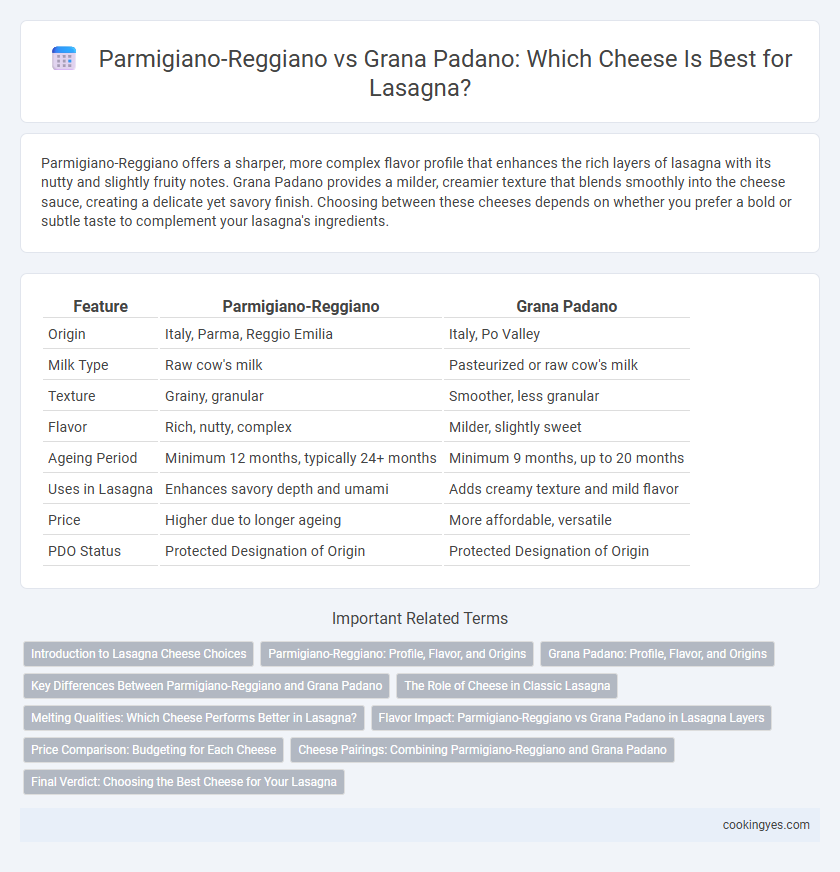Parmigiano-Reggiano offers a sharper, more complex flavor profile that enhances the rich layers of lasagna with its nutty and slightly fruity notes. Grana Padano provides a milder, creamier texture that blends smoothly into the cheese sauce, creating a delicate yet savory finish. Choosing between these cheeses depends on whether you prefer a bold or subtle taste to complement your lasagna's ingredients.
Table of Comparison
| Feature | Parmigiano-Reggiano | Grana Padano |
|---|---|---|
| Origin | Italy, Parma, Reggio Emilia | Italy, Po Valley |
| Milk Type | Raw cow's milk | Pasteurized or raw cow's milk |
| Texture | Grainy, granular | Smoother, less granular |
| Flavor | Rich, nutty, complex | Milder, slightly sweet |
| Ageing Period | Minimum 12 months, typically 24+ months | Minimum 9 months, up to 20 months |
| Uses in Lasagna | Enhances savory depth and umami | Adds creamy texture and mild flavor |
| Price | Higher due to longer ageing | More affordable, versatile |
| PDO Status | Protected Designation of Origin | Protected Designation of Origin |
Introduction to Lasagna Cheese Choices
Parmigiano-Reggiano and Grana Padano are both popular cheese choices for lasagna, each offering distinct flavors and textures. Parmigiano-Reggiano provides a rich, nutty taste with a granular texture that melts beautifully into the layers, enhancing the dish's depth. Grana Padano delivers a milder, creamier profile that complements the tomato sauce and bechamel without overpowering other ingredients.
Parmigiano-Reggiano: Profile, Flavor, and Origins
Parmigiano-Reggiano, known as the "King of Cheese," originates from specific regions in Italy including Parma, Reggio Emilia, and Modena, where strict traditional methods ensure its authenticity. Its rich, nutty flavor with hints of fruit and umami makes it a superior choice for lasagna, enhancing the dish's depth with a complex, savory profile. Grana Padano, while similar, offers a milder and less aged alternative but lacks the distinct, robust character and PDO certification that define Parmigiano-Reggiano.
Grana Padano: Profile, Flavor, and Origins
Grana Padano, a semi-fat hard cheese from the Po River Valley in Northern Italy, offers a rich, slightly sweet, and nutty flavor profile that enhances the depth of lasagna layers. Its granular texture and balanced saltiness melt beautifully, providing a creamy consistency that complements tomato sauce and bechamel. Unlike Parmigiano-Reggiano, Grana Padano has a shorter aging period of 9-20 months, resulting in a milder taste ideal for achieving a harmonious cheese blend in traditional lasagna recipes.
Key Differences Between Parmigiano-Reggiano and Grana Padano
Parmigiano-Reggiano and Grana Padano differ primarily in production regions, aging periods, and flavor profiles, with Parmigiano-Reggiano aged 12 to 36 months offering a more complex, nuttier taste ideal for lasagna. Grana Padano, aged 9 to 24 months, provides a milder, creamier texture, making it suitable for a subtler cheese layer in the dish. Both cheeses contribute rich umami but selecting Parmigiano-Reggiano enhances authenticity and depth in traditional Italian lasagna recipes.
The Role of Cheese in Classic Lasagna
Parmigiano-Reggiano enhances classic lasagna with its rich, nutty flavor and granular texture, melting evenly to create a savory, umami depth integral to authentic Italian recipes. Grana Padano offers a milder, creamier alternative that blends smoothly, contributing a subtle sweetness while maintaining the dish's cheesy intensity. Both cheeses provide essential saltiness and complexity, balancing the rich tomato sauce and bechamel, which elevates the layered structure and overall taste of traditional lasagna.
Melting Qualities: Which Cheese Performs Better in Lasagna?
Parmigiano-Reggiano offers a sharper, nuttier flavor with a granular texture that doesn't melt as smoothly in lasagna, providing a more pronounced taste but less creaminess. Grana Padano melts more evenly, creating a creamier texture that blends well with bechamel sauce and other ingredients, enhancing the overall mouthfeel of the lasagna. For a balance of flavor and melt quality, combining both cheeses can result in an optimal lasagna texture and taste.
Flavor Impact: Parmigiano-Reggiano vs Grana Padano in Lasagna Layers
Parmigiano-Reggiano delivers a robust, nutty flavor with a granular texture that layers depth and complexity into lasagna, enhancing both the sauce and cheese blend. Grana Padano offers a milder, creamier taste with a slightly less aged profile, providing a smooth cheese layer that complements but does not overpower other flavors. Using Parmigiano-Reggiano intensifies the overall savory experience, while Grana Padano creates a subtler, more balanced flavor in lasagna layers.
Price Comparison: Budgeting for Each Cheese
Parmigiano-Reggiano typically commands a higher price due to its longer aging process and strict production regulations, often costing between $25 to $40 per pound. Grana Padano is more budget-friendly, usually priced around $15 to $25 per pound, making it an economical choice for lasagna without significantly compromising flavor. When budgeting for lasagna cheese, selecting Grana Padano can reduce costs while still providing a rich, nutty taste comparable to Parmigiano-Reggiano.
Cheese Pairings: Combining Parmigiano-Reggiano and Grana Padano
Parmigiano-Reggiano and Grana Padano offer complementary flavor profiles that elevate lasagna, with Parmigiano-Reggiano providing a sharp, nutty intensity and Grana Padano contributing a milder, creamier texture. Combining these cheeses creates a balanced taste and perfect melting consistency, enhancing the dish's richness and depth. For optimal lasagna cheese pairings, use Parmigiano-Reggiano for finishing and Grana Padano within the layers to maximize flavor harmony.
Final Verdict: Choosing the Best Cheese for Your Lasagna
Parmigiano-Reggiano offers a richer, nuttier flavor and crumbly texture that enhances the depth of traditional lasagna, while Grana Padano provides a milder, creamier taste with a slightly granular consistency. For a classic, authentic Italian lasagna, Parmigiano-Reggiano is preferred due to its complex flavor profile and aging process, typically 24 months or more, which intensifies its savory qualities. Grana Padano serves as a budget-friendly alternative that melts smoothly and complements lasagna without overpowering other ingredients.
Parmigiano-Reggiano vs Grana Padano for Lasagna Cheese Infographic

 cookingyes.com
cookingyes.com